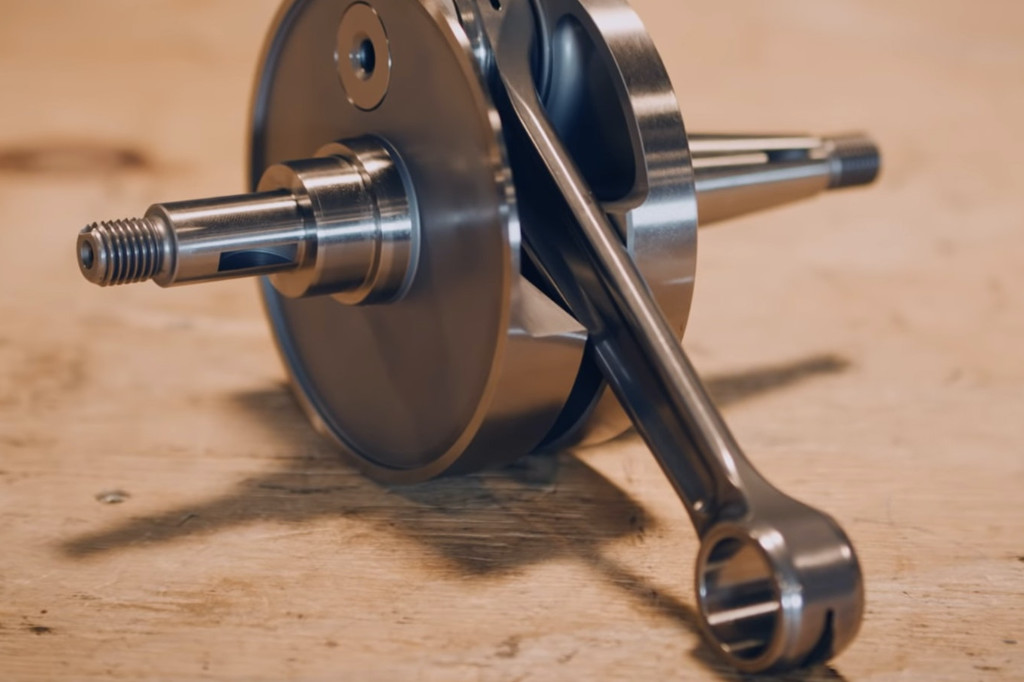Without a crankshaft, there is no running Vespa. This is how the relevance of the crankshaft in a Vespa can be described in five words. The task of the crankshaft is to convert the energy generated by combustion into a rotary motion. With the help of the connecting rod, a torque is generated which drives the rear wheel and thus makes driving possible. The crankshaft is necessarily one of the most robust components on the entire scooter, as it is constantly braked or accelerated in the direction of rotation.
Torque as the decisive variable
Power equals torque times speed. From this simple formula it follows that the torque must be increased if the power is to be increased. The torque basically results from the cubic capacity of the Vespa. There are specific upper limits that cannot be exceeded from a purely technical point of view. The reason for this is that only the entire mixture can be filled and burnt per piston stroke (more on this in our article on two- and four-stroke engines). The best possible filling of the cylinder is achieved primarily through more stroke and/or more bore. Two important terms that will be discussed in more detail below.
Stroke – what is it?
For many Vespa riders who have had little or nothing to do with crankshafts and bore or stroke, this term will probably mean little.
The stroke, or piston stroke, is the distance the piston travels in the cylinder. This distance from top dead centre to bottom dead centre is the stroke. In order to achieve more stroke, a longer distance is needed between these two points. In practice, this is achieved by so-called long-stroke shafts, in which the stroke pin is arranged further away from the crankshaft’s axis of rotation than in the case of a normal crankshaft. However, since the distance between top and bottom dead centre remains the same with an unchanged piston and cylinder head, the piston with long-stroke shaft would hit the head. This problem is circumvented by fitting appropriate head or foot seals, which extend the travel accordingly.
In a way, the bore acts as a counterpart. More bore is achieved by special tuning cylinders, which will not be discussed in detail here.
The cheek of a crankshaft
In order to fill the cylinder optimally, it is necessary for the mixture to flow through the overflow channels as quickly as possible. However, this can only be achieved if the pressure in the crankcase is as high as possible when the transfer ports open. This pressure is higher the smaller the ratio of the volume of the crankcase between the uppermost and lowermost piston position. A high pressure is generated by the smallest possible air volume in the crankshaft housing. Crankshafts with full crank webs that fill a large part of the crankcase are therefore ideally suited for this purpose. For this reason, so-called full cheek shafts are often used – especially in tuning – which, due to their size, already allow a smaller air volume than others.
The magic three: cone, bearing and oil seal
All three of these points, cone, bearing and oil seal, play a very important role in differentiating crankshafts. While the new models tend to have more in common here, there were still clear differences in the smallframe models. The old models, such as the V50 or ET3, have a standard shaft with a pointed cone on which the fan wheel is mounted. However, this cone is not very robust and can break off even with slight tuning measures.
The PK XL series cone is much more stable. This crankshaft has a blunt cone with a 20 mm diameter of the oil seal seat and the same bearing seat diameter of 20 mm. As this cone is much more stable, it is suitable for conversion to electronic ignition as well as for larger tuning projects. However, the even more stable crankshafts of the PK125XL series will not be discussed in detail here, as these cannot be installed without adjustments to bearings and oil seals.
In general, the topic “crankshaft” is mainly of a technical nature, which can often be very complex, especially in tuning projects. This text only roughly outlines the essential points and characteristics of the crankshaft.
Jesco, who works as a technician and developer at SIP Scootershop and is well known in motorcycle circles, offers a brief overview of various crankshaft models in the following video:


